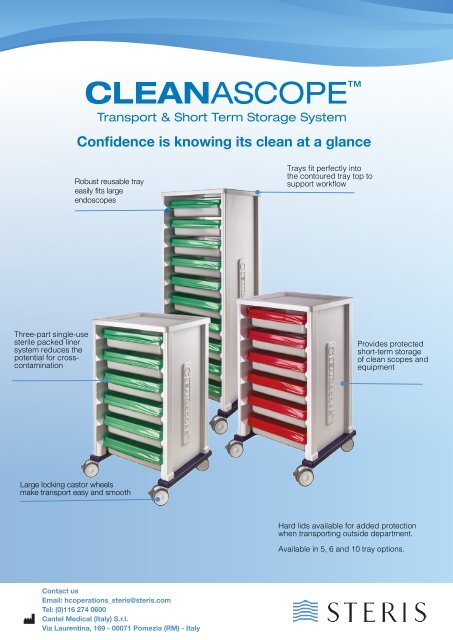Gastroenterology Today Winter 2023
Gastroenterology Today Winter 2023
Gastroenterology Today Winter 2023
Create successful ePaper yourself
Turn your PDF publications into a flip-book with our unique Google optimized e-Paper software.
FEATURE<br />
FEATURE<br />
Three-part single-use<br />
sterile packed liner<br />
system reduces the<br />
potential for crosscontamination<br />
GASTROENTEROLOGY TODAY – WINTER <strong>2023</strong><br />
CLEANASCOPE <br />
Transport & Short Term Storage System<br />
Confidence is knowing its clean at a glance<br />
Robust reusable tray<br />
easily fits large<br />
endoscopes<br />
Large locking castor wheels<br />
make transport easy and smooth<br />
CLEANASCOPE <br />
Transport & Short<br />
Term Storage System<br />
CLEANASCOPE ® Family<br />
Contact us<br />
Email: hcoperations_steris@steris.com<br />
Transport & Short Term Storage Carts<br />
Tel: (0)116 274 0600<br />
18 19<br />
Cantel Medical (Italy) S.r.l.<br />
Via Laurentina, 169 - 00071 Pomezia (RM) - Italy<br />
Trays fit perfectly into<br />
the contoured tray top to<br />
support workflow<br />
Provides protected<br />
short-term storage<br />
of clean scopes and<br />
equipment<br />
Hard lids available for added protection<br />
when transporting outside department.<br />
Available in 5, 6 and 10 tray options.<br />
NON-ALCOHOLIC FATTY LIVER<br />
DISEASE IN HEMOCHROMATOSIS<br />
PROBANDS WITH IRON OVERLOAD<br />
AND HFE P.C282Y/P.C282Y<br />
James C. Barton 1,2*† , J. Clayborn Barton 2† and Ronald T. Acton 2,3†<br />
Barton et al. BMC <strong>Gastroenterology</strong> (<strong>2023</strong>) 23:137 https://doi.org/10.1186/s12876-023-02763-x<br />
RESEARCH<br />
Abstract<br />
Background The aim of this study was to identify characteristics<br />
of non-alcoholic fatty liver disease (NAFLD) in adults<br />
with HFE p.C282Y/p.C282Y.<br />
Methods We retrospectively studied non-Hispanic white<br />
hemochromatosis probands with iron overload (serum ferritin (SF) ><br />
300 μg/L (M), > 200 μg/L (F)) and p.C282Y/p.C282Y at non-screening<br />
diagnosis who did not report alcohol consumption > 14 g/d, have<br />
cirrhosis or other non-NAFLD liver disorders, use steatogenic<br />
medication, or have diagnoses of heritable disorders that increase<br />
NAFLD risk. We identified NAFLD-associated characteristics using<br />
univariate and multivariable analyses.<br />
Results There were 66 probands (31 men, 35 women), mean age<br />
49 ± 14 (SD) y, of whom 16 (24.2%) had NAFLD. The following<br />
characteristics were higher in probands with NAFLD: median SF<br />
(1118 μg/L (range 259, 2663) vs. 567 μg/L (247, 2385); p = 0.0192);<br />
prevalence of elevated ALT/AST (alanine/aspartate aminotransferase)<br />
(43.8% vs. 10.0%; p = 0.0056); and prevalence of type 2 diabetes<br />
(T2DM) (31.3% vs. 10.0%; p = 0.0427). Mean age, sex, and prevalences<br />
of human leukocyte antigen-A*03 positivity, body mass index ≥ 30.0<br />
kg/m 2 , hyperlipidemia, hypertension, and metabolic syndrome in<br />
probands with/without NAFLD did not differ significantly. Logistic<br />
regression on NAFLD using variables SF, elevated ALT/AST, and T2DM<br />
revealed: SF (p = 0.0318; odds ratio 1.0–1.0) and T2DM (p = 0.0342;<br />
1.1–22.3). Median iron removed to achieve iron depletion (QFe) in<br />
probands with/without NAFLD did not differ significantly (3.6 g (1.4–7.2<br />
g) vs. 2.8 g (0.7–11.0 g), respectively; p = 0.6862).<br />
Conclusions NAFLD in hemochromatosis probands with p.C282Y/p.<br />
C282Y is associated with higher median SF and greater T2DM<br />
†<br />
James C. Barton, J. Clayborn Barton and Ronald T. Acton contributed equally to this work.<br />
*Correspondence:<br />
James C. Barton<br />
bartonjames336@gmail.com<br />
1<br />
Department of Medicine, University of Alabama at Birmingham, Birmingham, AL, USA<br />
2<br />
Southern Iron Disorders Center, Birmingham, AL, USA<br />
3<br />
Department of Microbiology, University of Alabama at Birmingham, Birmingham, AL, USA<br />
prevalence, after adjustment for other factors. NAFLD does not<br />
influence QFe significantly.<br />
Keywords Alanine aminotransferase, Aspartate aminotransferase,<br />
Metabolic syndrome, Obesity, Serum ferritin, Type 2 diabetes<br />
Background<br />
Non-alcoholic fatty liver disease (NAFLD) is a spectrum of liver<br />
abnormalities characterized by steatosis (lipidfilled vacuoles in<br />
hepatocytes), steatohepatitis (steatosis and hepatocyte “ballooning”<br />
with inflammation and necrosis), fibrosis, and cirrhosis [1, 2]. It has<br />
been estimated that 25.2% (95% confidence interval (CI) [22.1, 28.7]) of<br />
persons world-wide have NAFLD [2]. In a metaanalysis of 34 studies,<br />
the prevalence of NAFLD in U.S. whites was 14.4% (95% CI [14.0, 14.8])<br />
[3]. Co-morbid conditions associated with NAFLD include obesity,<br />
type 2 diabetes (T2DM), hyperlipidemia, hypertension, and metabolic<br />
syndrome (MetS) [2].<br />
Hemochromatosis in whites of western European descent is<br />
associated with homozygosity for HFE p.C282Y (rs1800562),<br />
a common missense allele of the homeostatic iron regulator<br />
(chromosome 6p22.2) in linkage disequilibrium with human<br />
leukocyte antigen (HLA)-A*03 [4, 5]. HFE, a non-classical class I<br />
major histocompatibility complex protein, is an upstream regulator<br />
of hepcidin and thus of iron homeostasis [6]. Laboratory phenotypes<br />
of many adults at diagnosis of hemochromatosis and p.C282Y/p.<br />
C282Y include elevated levels of transferrin saturation (TS) and serum<br />
ferritin (SF) [7]. Adults with p.C282Y/p.C282Y have increased risks to<br />
develop iron overload. Severe iron overload occurs predominantly in<br />
men [7, 8]. Non-HFE heritable and environmental variables modify iron<br />
loading in adults with hemochromatosis [5, 7, 9, 10]. Some adults with<br />
p.C282Y/p.C282Y also have hemochromatosis arthropathy, diabetes<br />
mellitus, hypogonadotropic hypogonadism, hepatic cirrhosis, or<br />
cardiomyopathy [7].<br />
GASTROENTEROLOGY TODAY – WINTER <strong>2023</strong>
















